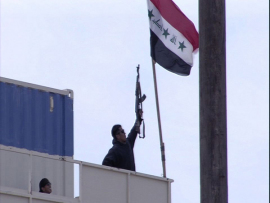
Naeem Mohaiemen: Understanding Vietnam Anti-War Movement
There seems to be a streak of romantic nostalgia and longing for the Vietnam Anti-war movement.
Why can't kids today just get it together, goes the collective sigh.
It's ahistorical to compare the size of the antiwar movement in 1968-1970 with that of 2006. You have to look at the entire buildup from 1950s on to make a parallel comparison. Alexander Cockburn points out that, as far back as 1954, Eisenhower secretly decreed that Ho Chi Minh could not be permitted to win open elections. There was no media revelation and the left took another decade to get up to speed on Vietnam. Camelot worship was so strong that even Kennedy's decision to send detachments of US troops as "advisors" to South Vietnam (setting the stage for the assassination of Ngo Dinh Diem) did not inflame an antiwar movement. It took the buildup all the way to 1967/68 which led the organized left to stage large-scale, successful antiwar rallies. All this occurred in an environment of 1968 and what felt like a worldwide anti-imperialist movement (which also created incorrect predictions, as when Tariq Ali described the massive upheavals in Pakistan as "people's power", but by 1971 the movement had been hijacked by the middle class urban elite of the Awami League who became leaders of an independent nation of Bangladesh).
The national draft was always a structural force that was the LARGEST factor in creating and sustaining a massive antiwar movement, as well as fomenting a major breakdown of military discipline and mass desertions towards the end of the war. As described in the film SIR, NO SIR, the movement spread to barracks, aircraft carriers, army stockades, navy brigs, military bases and elite military colleges like West Point. According to the Pentagon’s own figures, 503,926 desertions occurred between 1966 and 1971. Over a hundred underground newspapers were published by soldiers; national antiwar GI organizations were joined by thousands; and stockades and federal prisons filled up with soldiers jailed for their opposition. By the early 1970s, entire platoons refused to fight and "fragging" (friendly fire killing commanding officers), rampant drug use and open insubordination became the hallmark of a totally demoralized army-- many of whom came home and became robust (and invincible in the context of image politics) visual icons of the antiwar movement. Structurally today's conflict can NEVER produce that kind of movement because joining the military is now an economic option, limited to working class Black, Latino and White kids. By removing the middle class and elite from the possibility of the draft, the military has successfully defanged the key driver. In addition, we should not under-estimate the shrewdness and adaptability with which the US Army took concrete steps to professionalize the army and provide carrots to mollify dissent (today considered one of the most integrated organizations in America, providing "affirmative" opportunities particularly to minorities).
Here's an excellent anti-recruitment flash animation created by a group of young antiwar protest groups (Yes, Virginia, we contain multitudes), which combines elements of SIR, NO SIR, with today's anti-recruitment drives.
https://www.youtube.com/watch?v=3TUmCJciwI8
> Naeem Mohaiemen

